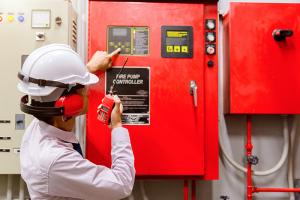Hospitals have options for damper inspections
The American Society for Health Care Engineering (ASHE) has received many inquiries about the qualifications required for individuals conducting inspections and testing of fire, smoke and/or or combination fire and smoke dampers. According to the National Fire Protection Association’s NFPA 80, Standard for Fire Doors and Other Opening Protectives, inspectors must be "qualified," meaning they possess a recognized degree, certificate, professional standing or relevant skill, and have demonstrated the ability to manage the subject matter through knowledge, training and experience. This qualification allows engineering staff to perform these inspections, as their skills and potentially in-house training by experienced staff provide the necessary expertise. While some facilities may opt for contracted services to carry out these inspections, many facilities — especially rural and critical access hospitals — routinely rely on in-house staff for this task.
Several jurisdictions, including Nevada, Hawaii, New Mexico, St. Louis, Pittsburgh, Toledo, Delaware, Illinois and Washington state, have received petitions from interest groups advocating for inspections to be conducted solely by individuals certified by an accredited body under the International Organization for Standardization’s and International I Electrotechnical Commission’s ISO/ICE 17024, Conformity assessment — General requirements for bodies operating certification of persons. ASHE recognizes the vital importance of these inspections for fire and life safety but expresses concern about the limited availability of certified personnel for contracting purposes.
The encouraging news is that the list of accrediting bodies is expanding. The American National Standards Institute (ANSI) maintains an updated directory of accredited certification bodies under the ISO/IEC 17024 standard. Inspectors must hold valid certifications from recognized organizations, including:
International Certification Board (ICB): ICB Fire and Smoke Damper Technician
Safenetix: Safenetix Level 1 Certified Fire and Smoke Damper Inspector
The ANSI website is updated regularly to include new certification bodies, and ASHE recommends checking it periodically for the latest information.
Although possessing these certifications is valuable for fire and life safety compliance, it does not automatically make someone qualified to work within the health care environment. Activities performed above ceilings in health care facilities must be handled with caution, as improper execution can expose patients to harmful dust accumulation. This dust can contain allergens, mold spores and other potential health hazards that can be stirred up and spread throughout the hospital when disturbed. These above-ceiling activities can also disrupt patient care or impair other protective systems.
Contractors working in health care settings must understand the specific operational needs of the facility. Certifications such as ASHE’s Health Care Physical Environment Worker Certificate are considered the gold standard for ensuring contractors are well-versed in the unique requirements of the health care built environment.
Chad Beebe, AIA, CHFM, CFPS, CBO, FASHE, is deputy executive director, ASHE Regulatory Affairs.




